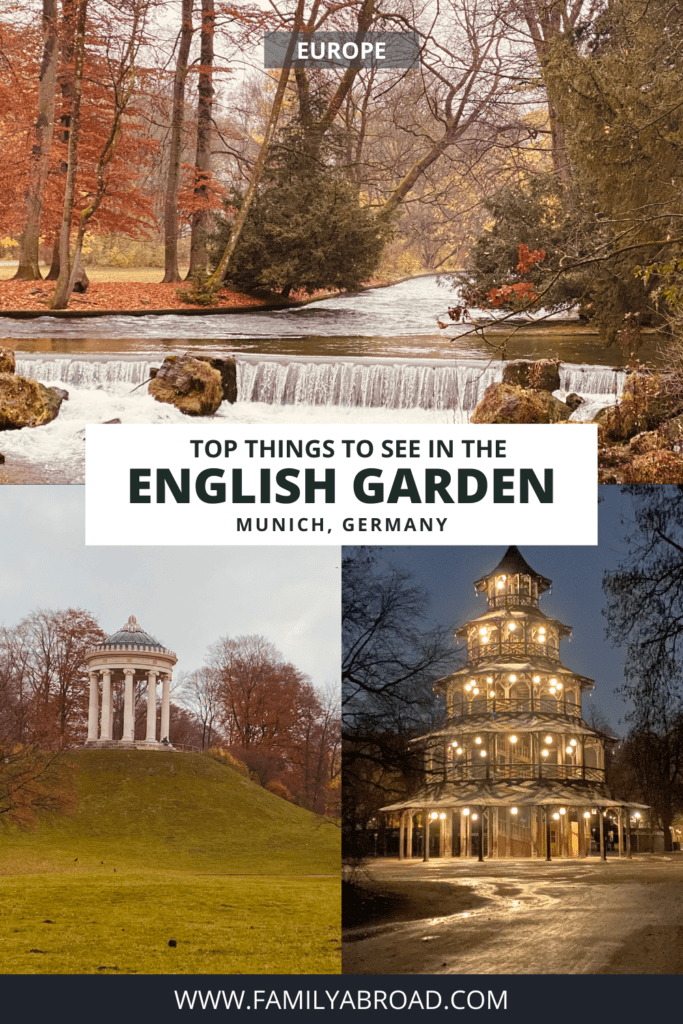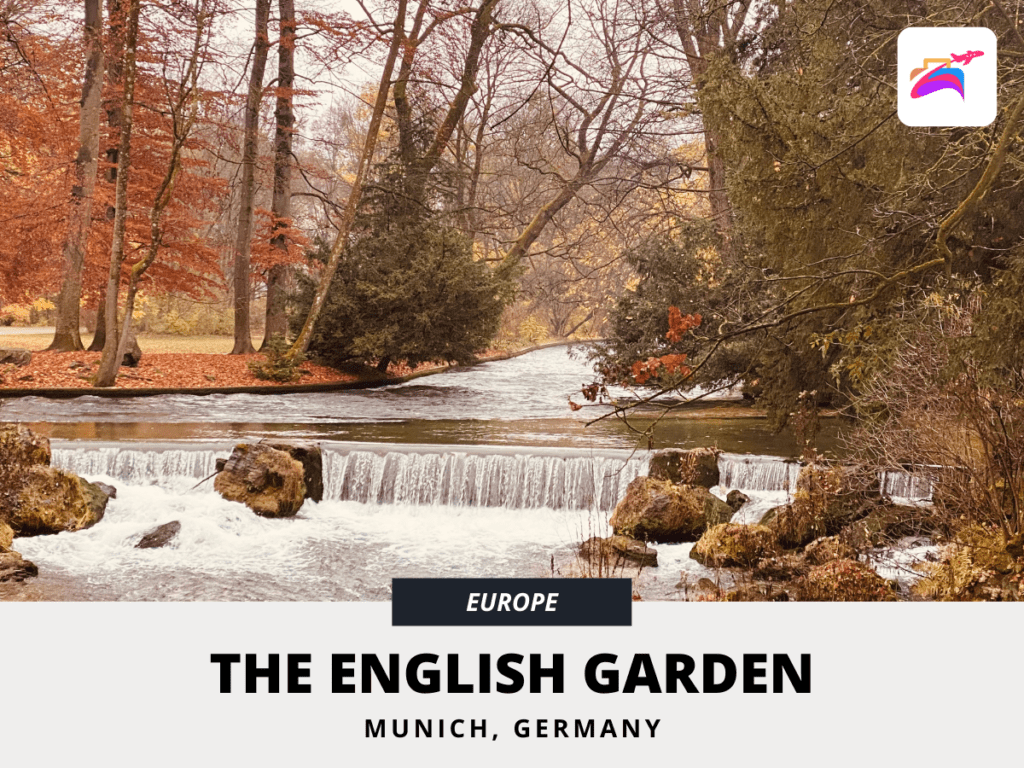English Garden, A Guide for Families
Introduction
Overview
History of the Park
Must See/Do: Attractions, Landmarks and Events
Conclusion
Introduction
The Englischer Garten (translated to the “English Garden”) is located in the very heart of Bavaria in Munich, Germany, and it is truly amazing. I spent a great amount of time in the park – both with the family and on my own. To be honest, after seeing the wonderful parks in London (especially Hyde Park and St.James’ Park), I did not expect another park to come even come close, but I was wrong.
Overview
Did I mention that the popular park is huge? In fact, it boasts an impressive 42 million visitors per year, and, at 910 acres, the English Garden is even bigger than Central Park (843 acres) in New York City! Biking, walking, jogging, birding (over 50 species in the park), pedal boating, picnicking and even tightrope walking are just some of the activities you may come across while strolling the park.
To give some perspective of the park’s size, consider that the park has:
- 5 miles of wooded paths;
- Sheep to “mow” part of the meadows – Eco-Friendly and saves the park over $100,000/year;
- Places to eat, including several food kiosks, where you can enjoy local favorites such as “Brezel” (Bavarian hot pretzels) and “Bratwurst” (local sausages);
- 2 surfing areas;
- the equivalent to 640 European football pitches;
- 4 beer gardens to wash down all of the food;
- Over 100 Bridges; and
- Canals, Lakes, Islands, Streams (over 5 miles in length) and even Waterfalls;
History of the Park
English Garden was created in 1789 and was the brainchild of Sir Benjamin Thompson. Sir Thompson was a British loyalist who was born in Massachusetts and fought in the American Revolutionary War. After the war, he went to London where he became known for being a physicist and for his inventions, such as the Rumford Stove and thermal underwear (thank you, Sir Thompson!). Sir Thompson was even something of a celebrity for his Rumford Stove which made heating much more efficient by sending more smoke up the chimney instead of into the house. He was also known for his ability to organize and design just about anything, from warships to, yes, parks.
In 1784, Sir Thompson was hired by the Bavarian ruler to re-organize the Army and to pursue military reforms. One of the military reforms proposed that, during peaceful times, the soldiers should be given leave to perform civilian work, such as gardening and agriculture. Therefore, it was ordered that in each garrison city, a military garden would be built. The purpose of the military parks would be to allow the soldiers to learn valuable knowledge in the areas of farming and ranching. The area known as Hirschanger, and translated to “Deer Park”, was selected for the military park.
While re-organizing the Army, the French Revolution was underway and many leaders in Europe were rightly nervous. As a result, the leader of Bavaria decided that to appease any discord of the people, he would create a public park. Sir Thompson selected an English style of park which is more informal in design when compared with the more common formal style of a park like Versailles in France, which was master planned and had every row planned and everything aligned perfectly.
In 1792, the park officially opened, and 40,000 citizens attended opening day. At the English Garden, there was a military academy, a cattle farm, a sheep farm, a farming school, and a school of veterinary. The veterinary school still exists to this day.
After 11 years in Bavaria, Sir. Thompson left Bavaria. He later endowed a Professional Chair at Harvard University, which continues to make yearly awards in the arts and science. Sir Thompson died on August 21, 1814, and he is buried in Paris.
Must See/Do: Attractions, Landmarks and Events
After Sir Thompson left Bavaria, the park continued to grow and evolve. Over the years, the park expanded, and today’s most popular park landmarks and attractions were built as shown below (See Clickable Map). Be sure to check to make sure they are open when you visit as some are only open seasonally.
FAMILY TIP: Google Maps or another map type app will be your best friend. First, I dropped a pin at the location of the house where we stayed so that I could easily get both directions back to the house and to determine how long it would take me to walk back to the house. Most, if not all, of the places listed in this article are listed on the app, so navigating the park is easy (it even has all of the park’s paths). So, use technology to explore nature!
1. Chinese Tower
The Chinese Tower (Chinesischer Turm) was completed in 1790 during the pan European craze for anything “oriental”. While it has been burned down a few times, it was always rebuilt (most recently in 1952). It is 5 stories tall and rises up out of the park to about 80 feet in height. It resembles a Chinese pagoda, but with a distinctly Bavarian touch.
For beer lovers, this is the place to be during most of the year. The beer garden located next to the Chinese Tower can handle up to 7000 guests and traditional German brass bands offer patrons the sound of Bavarian happiness! There are many different food kiosks, and you can easily find traditional Bavarian food as well as some more international options.
The Chinese Tower is easily assessable by foot, bicycle or by bus.
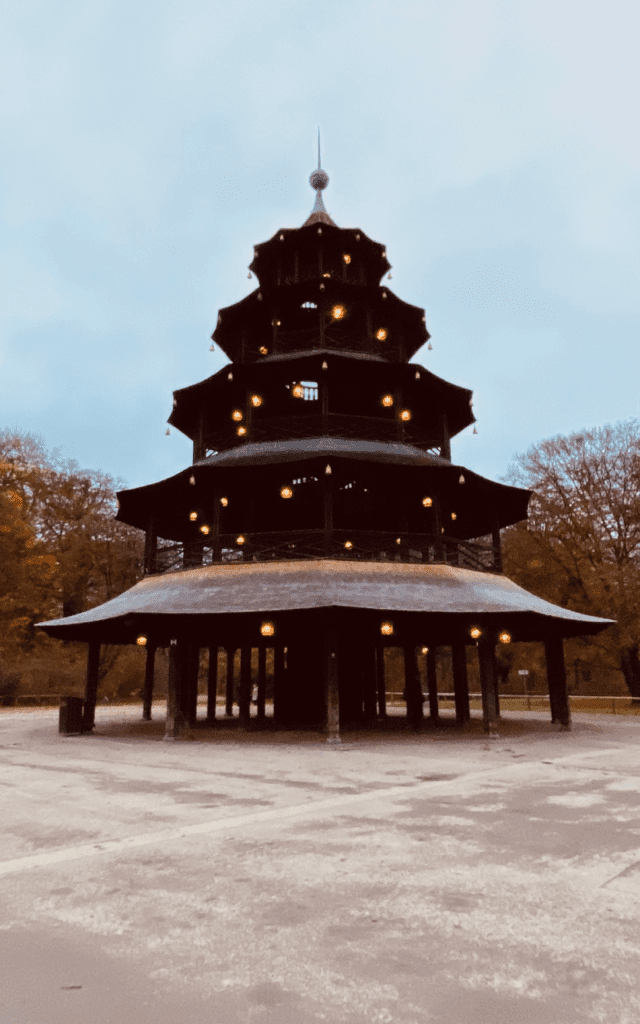
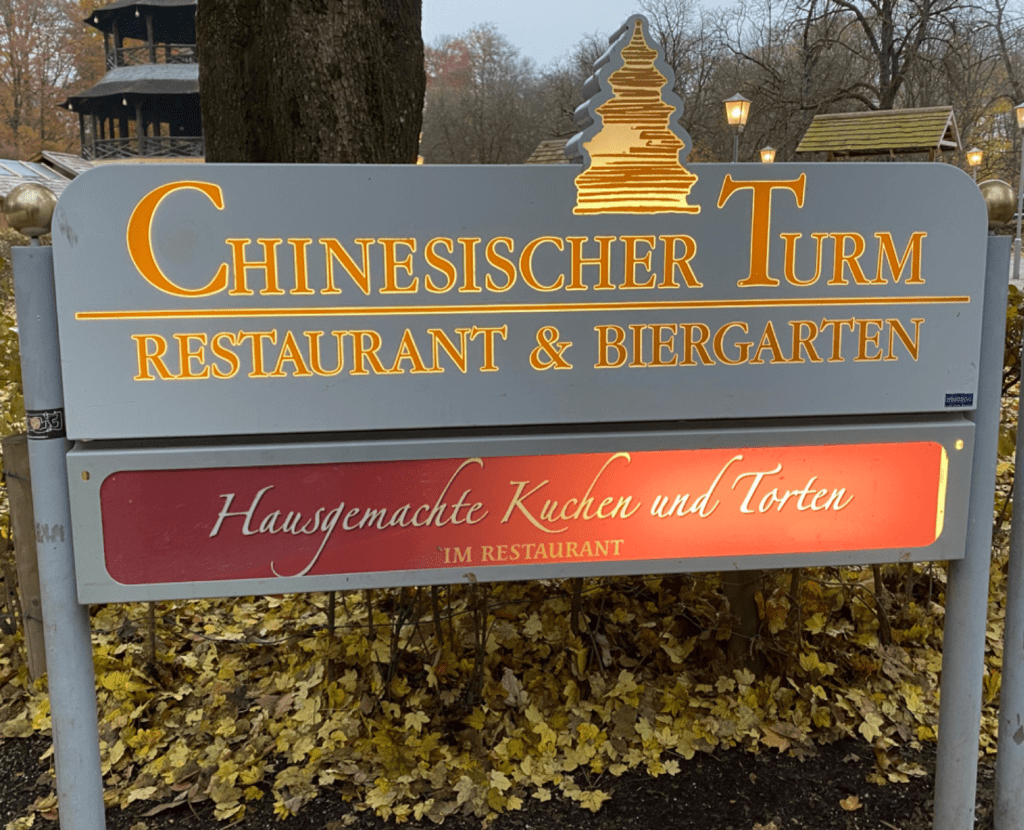
FAMILY TIP: You can bring your own food to most beer gardens but be prepared to buy your drinks at the beer garden.
1.a. The Cook’s Ball (Kucherball)
Started at the end of the nineteenth century, the Cook’s Ball started as a way for the cooks, maids, soldiers, and students to get together for a dance. At that time, up to 5,000 people would meet on Sunday mornings at 5am and they would dance throughout the day until 8pm, when they would return home to get ready for work.
In 1904, this custom was forbidden on “moral grounds” (reminiscent of “Footloose”?), but it was revived in 1989 as a dance to be celebrated once a year in July. So, if you happen to be in Munich on the third Sunday of July, be sure to attend the Cook’s Ball. But you better be ready to get up early because while it starts at 6am, you must arrive around 4:30am if you want to grab a table. Or you could always just stay up all night! And remember, even if you don’t get there early, you still can go by and enjoy the wonderful festivities.
1.b Chinese Tower Christmas Market (Chinesischer Turm Weihnachtsmarkt)
One of the reasons that we came to Munich was to see their famous Christmas markets. Unfortunately, the Chinese Tower Christmas Market was cancelled due to the Corona Virus. This is not totally surprising as Covid canceled all Christmas markets here in Munich last year (2020). So, be sure to check the official city list for active Christmas markets! We did find more than ten other Christmas markets to visit, so while we will miss the Chinese Tower Christmas Market, there are plenty of other Christmas markets to see.
The Chinese Tower Christmas Market is smaller, and more intimate, than the main Munich Christmas market, known as the (Christkindlmarkt) held in front of Munich Town Hall. During Advent, the Chinese Tower somehow undergoes a metamorphosis and becomes, truly, a winter wonderland. If you want horse-drawn carriage rides, vintage carousal rides with unique animals and a quieter night of shopping in the Christmas stalls, this is the place to visit.
FAMILY TIP: While the Chinese Tower Christmas Market is smaller in size, it does offer a lot of activities for children such as the merry-go-round dating back to 1913 as well as nearby playgrounds and restrooms. Plus, if you can get away for a date night, this is a definite place to consider for a romantic night.
2. Children’s Carousel
Dating to 1823 (and replaced in 1913), there is no doubt that generations of Munich’s people have memories etched into their minds of those special days spent sitting on an animal while mom or dad stood closely by. And the animals in this carousel are truly unique as they represent the ibex, storks, wild goats, flamingos and, of course, horses. If you have children, don’t miss this activity, but it is usually open only between April and September. The carousel is located next to the Chinese Tower.
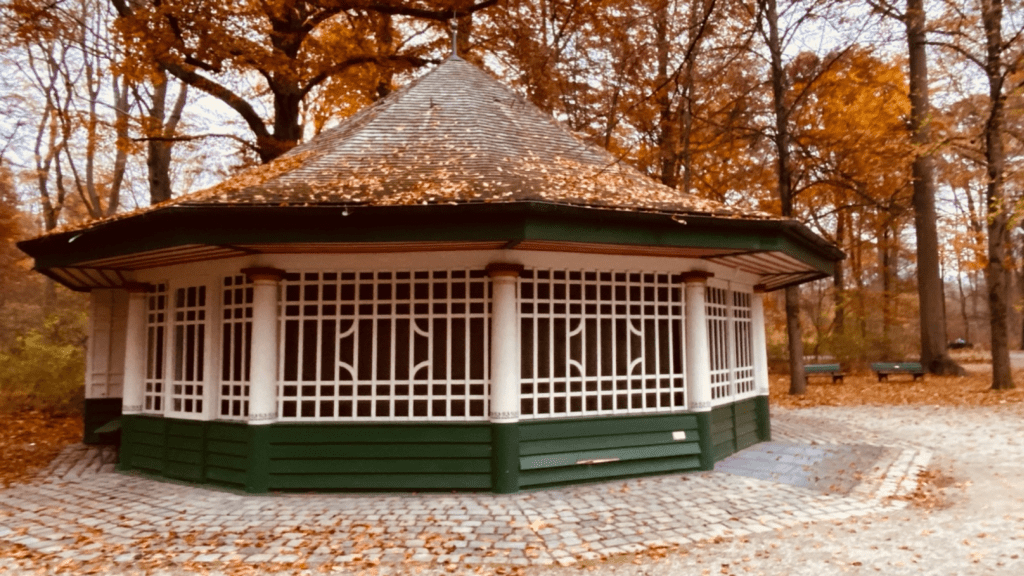
3. Monopteros
If you want great views of the park and of the Chinese Tower, this Greek style edifice is the place that you want to be! You can even see into the city on a clear day! In 1836, a hill was created, and a small stone building originally called “Monopteros Apollo Tempel” was built from leftover materials from the Royal Residence located in Munich. Ten columns support a dome under which is beautifully painted.
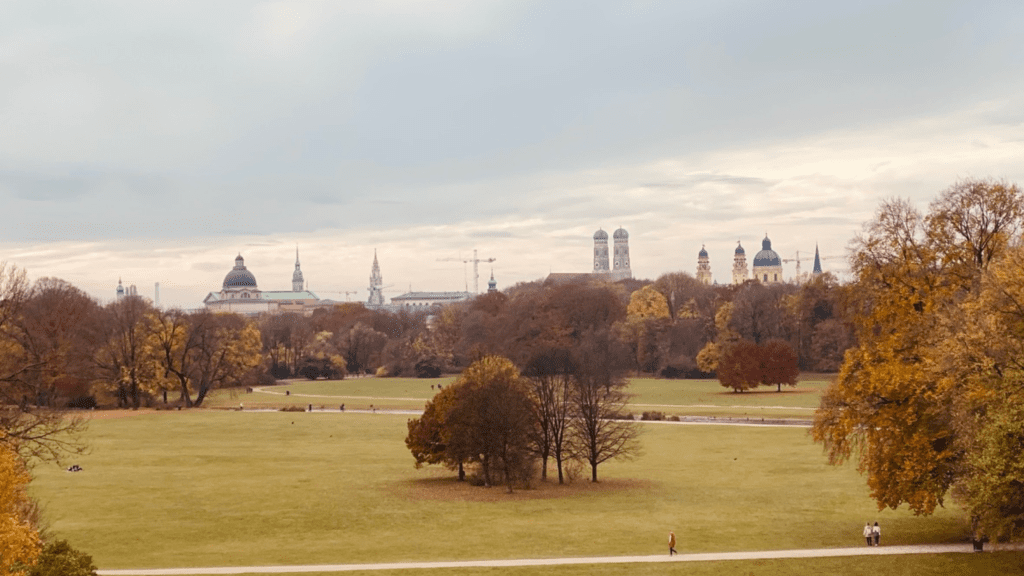
4. Steinerne Bank aka Klense’s Stone Bench
Klense’s Stone Bench is nearby and was built on the foundations of what used to be Apollo’s Temple. Apollo’s Temple was originally built in the mid-18th century. Unfortunately, it was built using wood and it fell into disrepair and only the foundation remained. In 1838, the bench was added with the following words etched into its stone: “Hier wo Ihr wallet, da war sonst Wald nur und Sunpf”, which translates to “Here where you meander was once only wood and marsh”.
5. Surfing
The people who surf at the 2 Eisbach waves (5(a) and 5(b) on the Map) are incredibly fun to watch. If you have an hour to just watch these athletes fight the currents of the streams, taking turns as they show off their skills, I highly encourage you to do so. But even if you just want to walk by for a few minutes, make the time. We walked by last night, and they were still surfing, using portable lights!
It should be noted that unless you are a very experienced surfer, this is not the place to test your skills. While the surfers we watched made it look easy, it is just too dangerous for the casual surfer. I should note that officially, surfing is strictly forbidden, but I think the law seems to the other way. This may be one of my shortest paragraphs, but this was a highlight of the park for me.
6. Japanese Teahouse
The Japanese Teahouse was built in 1971 because of the 1972 Summer Olympics being held in Munich. At the south end of the park, you can find the teahouse on a small island. The teahouse was donated to Bavaria by the head of a tea school located in Kyoto, Japan. If you want to find some tranquility, the Japanese Teahouse is a great place to visit.
6.a The Japanese Festival
Held on the third Sunday of July, this event is held by the German-Japanese Society of Bavaria and the Japanese Conul in Munich. Traditional Japanese dress is worn, and the festival is a wonderful introduction to all things Japanese.
6.b Traditional Tea Ceremonies
Traditional tea ceremonies are held here regularly. In fact, such ceremonies are regularly held on the second weekend of every month between April and October, on both Saturdays and Sundays. For many of the Japanese, drinking tea is an art that brings relaxation.
7. Nude Sunbathing at the Schonfeldwiese
Ok, this isn’t really a “Must See/Do”, but it does bear mentioning. I mention nude sunbathing for two reasons: 1) to know about it so you can avoid this activity if you don’t want to suddenly wander into this area of English Garden with your children and 2) to let you know that this activity is accepted and legal in certain sections of the English Garden.
In the 1960’s, nude sunbathing was a popular activity. And in the park, it was a sensation that became well-known all-around Europe. And while most people of Munich have a “leben und leben lassen” attitude (live and let live), don’t expect to engage in any sexual activity or use drugs.
If you want to participate, make sure to review the sections of the park that allow nude sunbathing. If you wander out of those areas, naked, you could be arrested. And while the sections usually have a sign in German stating that nudity is allowed in that area, the exact sections are not (unsurprisingly) marked on any of the maps spread throughout the park (for this reason, I did not mark any section on the above map). Don’t worry too much about running into this activity as the south side of the park has lost popularity as the number of tourists have increased. Just remember, if you just happen to be walking through an area, be cool and don’t whip out your camera!
8. KlienHesseloher See (Kleinhesseloher Lake) and the Seehaus
At what was once the northern edge of the park, a lake was created. Over time, it was expanded and improved. The enlargement of the lake brought it to the small village of Kleinhesselohe where an enterprising person decided to open a business selling beer and, eventually, food. As you can imagine, this became a popular walking area of the park!
While the original beer house is no longer present, a new restaurant called the Seehaus was built in 1985 and a beer garden is nearby. The area continues to be popular and pedal boats can be rented so that people can enjoy the lake.
9. Amphitheater
If you enjoy local plays and local theater, the Amphitheater provides a beautiful setting. It is an open-air venue with stair-stepped grass seating and stage. The Amphitheater is in the quiet, northern side of the park.
10. A Portion of the Berlin Wall – “Memorial to Freedom and Unification”
This monument is left off most maps and, personally, I think this important landmark should have been placed in a more prominent part of the park. It is located near the US Consulate on the southeastern border of the park on KoniginstraBe Street. In 1996, on the anniversary of the reunification of Germany, the memorial was opened. Go by and touch this important part of history – I promise you will feel both the heartache of the separated German people and the joy of being reunited.
11. Playgrounds
So far, I have come across three playgrounds in the southern part of the park. I am sure that there are several others.
11.a The first playground is easily found if you happen to be visiting the Chinese Garden or the Children’s Carousel as it is immediately next to both landmarks. This playground has two areas of play with plenty of benches for tired parents. The first area is for younger kids up to 6 years old. This is very small, but all the kids playing seemed very happy. The second area is larger and contains a great set up of a physically challenging playground for slightly older children.
11.b The second area is convenient for parents as it is behind the small beer garden/kiosk on the south side entrance of the park off KoniginstraBe Street. It is a nice setup with ground that doesn’t become mud and muck when it rains.
11.c The third playground was my nine-year old’s favorite because it had more room to play tag and hide-and-seek. Its location is harder to describe, but it is on the southeast side of the park, just behind the track field.
Conclusion
As I continue to explore the park, I continue to find new monuments, landscapes, and areas of beauty. I haven’t even explored one-half of the park, and I know much more remains to be discovered.
I found the English Garden to be very safe and I walked my kids home from the park after dark on several occasions without any worries or concerns. The park is beautiful in the Fall and I am sure it is beautiful with each season. Take your family, or go by yourself – I promise you will not regret the time in spend in the English Garden!
FAMILY TIP: Before you enter the park, look to see if there are bikes to rent. As of 2021, you could rent a bike by the hour or by the day (15 euros/day). You probably won’t need a bike to see the main landmarks in the park, but if you are planning to explore the north side of the English Garden, it would be highly recommended to grab a bicycle.
WATCH THE FULL VIDEO HERE
Like this post? Pin it on Pinterest!
